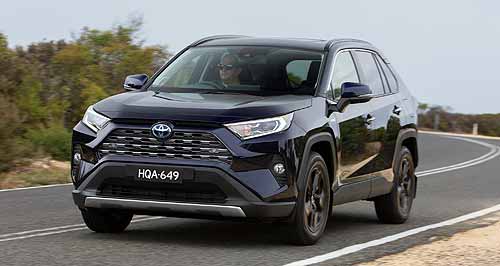Make / Model Search
News - Market Insight - Market Insight 2021Market Insight: Hybrid sales soar in JanuaryCharging ahead: Hybrid sales have experienced a large spike, thanks to models like the Toyota RAV4. Hybrid SUV sales leap 115 per cent in Jan as market embraces alternative vehiclesGallery Click to see larger images 8 Feb 2021 By NEIL DOWLING HYBRID sales have been a glaring high-beam light as the new-car market endured a rollercoaster ride through the pandemic – hitting lows with dealership closures and product delays and highs with soaring customer demand – to end 2020 with a relatively comfortable 13.7 per cent drop on 2019.
Sales of hybrid vehicles ended the year up a whopping 93.7 per cent on 2019 and the trend is showing its momentum by carrying the roll through to last month.
In the combined passenger car, SUV and light-commercial vehicle (LCV) segment, hybrid sales in January 2021 are up 34 per cent on January 2020.
Get the alternative electrified vehicles together and combine battery-electric vehicles, hybrids and plug-in hybrids (PHEVs) and sales are up 35 per cent – all in a month where total vehicle sales (including petrol and diesel) rose by 11.1 per cent.
The standout is the SUV sector. Hybrid sales of SUVs in one year have surged 114.7 per cent to 3332 units in January this year.
Sales of PHEV SUVs – think hybrid with an extension cord – for the same period are up 121.1 per cent.
The surge in popularity of hybrids – as apart from full battery EVs and PHEVs – is seen with the 5247 sales in January this year, up from 3473 sales in the same month last year.
In comparison with the passenger car, SUV and LCV segment total in January 2021 of 77,619 units, hybrids represented 6.8 per cent.
This is up on the same month in 2020 when the segment’s hybrid contribution was only 5 per cent, and in January 2019 when hybrids held a marginal 2.2 per cent of the total segment.
It is further boosted when PHEVs are combined with hybrids. Effectively, they use very similar components though PHEVs have a large storage battery and can be topped up by plugging the vehicle into an electricity source.
Why the interest in hybrids? In one word, fuel economy. The Toyota RAV4 Hybrid – which for August last year was the nation’s most popular car (combined with ICE variants) – claims 4.8 litres per 100 kilometres compared with the non-hybrid RAV4 at 6.5L/100km.
In the real world, fuel consumption is around 6.0L/100km (hybrid) and 8.8L/100km (petrol) which means a 12,000km average annual distance would save about $440 a year.
The fuel use is attractive, though the $2500 price difference between the RAV4 petrol and hybrid means it would take over five and a half years to break even.
That’s the worst case. Drive the hybrid in city conditions or congested traffic and the engine may rarely be used, allowing the electric motor to do the driving and considerably slashing the petrol bill.
Hybrids running on the electric motor are quieter than a conventional petrol-fuelled vehicle, which also attracts buyers, along with the warm feeling of owning a car that ostensibly uses less fossil fuels and so is better for the environment and the family.
In terms of sales, Toyota’s RAV4 Hybrid is the nation’s most popular hybrid vehicle. In August last year the hybrid was 91 per cent of RAV4 total sales.
Hybrids in the Toyota camp now include the Camry, Corolla, RAV4, Yaris, C-HR, Prius and Prius V with Kluger expected in the first half of this year.
Toyota’s hybrids now represent more than 25 per cent of the brand’s total sales in Australia.
Customers want more and the market is set to deliver in 2021. The hybrid evolution continues in 2021 in Australia with at least five new models, plus five full-EVs. The hybrids include the Ford Escape PHEV, Kia Sorento PHEV and hybrid, MG HS PHEV and Toyota Corolla Cross Hybrid and Kluger Hybrid.
One of the drivers to hybrids has been fleets.
Paul Oliver, director and principal consultant with Sydney-based fleet management firm Fleet Advisory, told GoAuto that vehicle whole-of-life analysis was showing that enhanced resale values, coupled with improved fuel economy, offset the difference in purchase price over available petrol-only engine models.
“Additionally, their lower carbon emissions contribute to corporate sustainability and environmental policies,” he said.
“Many would argue that we should be jumping straight from combustion engines to battery-electric vehicles (BEVs) to reach zero-emission targets.
“However, with a lack of infrastructure and coherent government policy, Australia is so far falling behind in the race to electrification.”
Mr Oliver said while infrastructure appeared to be the biggest obstacle, the pricing gap to BEVs and “range anxiety” were still major issues for fleets.
“This is where hybrid vehicles are playing an important role in transitioning us to electrification,” he said.
“They allow consumers to ease their way into acceptance of electric-vehicle technology. They provide that ‘stepping stone’ that makes the purchase decision so much more comfortable, while still making an eco-friendly contribution.
“Hybrid vehicles are paving the way for us all to gradually transition to BEVs and it seems that some fleets are now realising the benefits.”  |
Click to shareMarket Insight articlesResearch Market Insight Motor industry news |










Facebook Twitter Instagram